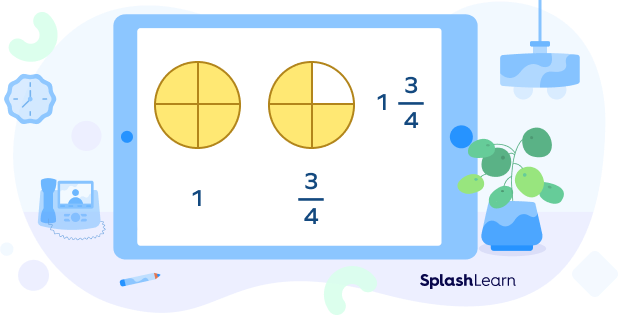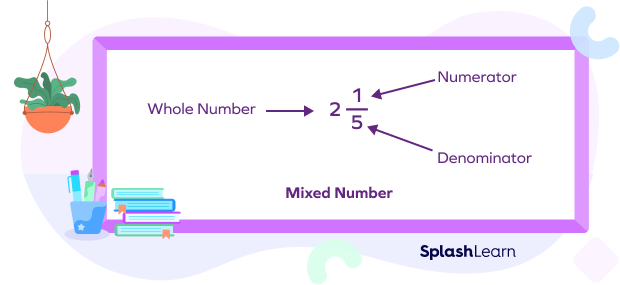What Is Multiplying Mixed Numbers?
Multiplying mixed numbers refers to finding the product of two mixed numbers. Before delving into the steps and examples, let’s take a moment to review some essential basics.
A fraction represents parts of a whole. If a cake is divided into eight equal pieces, and three pieces of the cake are placed on a plate, then we can say that the plate has $\frac{3}{8}$ of the cake.
There are three types of fractions:
| Proper Fractions | Improper Fractions | Mixed Numbers(Mixed Fractions) |
|---|---|---|
| Numerator < Denominator | Numerator ≥ Denominator | Consists of a whole number and a proper fraction |
| They lie between 0 and 1. | 1 or greater than 1 | 1 or greater than 1 |
| Examples: $\frac{1}{2}, \frac{3}{4}, \frac{7}{12}$ | Examples: $\frac{3}{2}, \frac{12}{5}, \frac{8}{3}$ | Examples: $3\frac{1}{2}; 2\frac{2}{3}; 2\frac{1}{7}$ |
Let’s explore mixed numbers.
Recommended Games
What Are Mixed Numbers?
A mixed number or a mixed fraction consists of a whole number and a proper fraction. It generally represents a number between any two whole numbers.
Look at the given image. It represents a fraction that is greater than 1 but less than 2. It is a mixed number.

Some other examples of mixed numbers are:

- Parts of a Mixed Number
A mixed number is formed by combining three parts: a whole number, a numerator, and a denominator. The numerator and denominator are part of the proper fraction that makes the mixed number.

Recommended Worksheets
How to Multiply Fractions
Before we discuss how to multiply mixed numbers, let’s quickly understand how to multiply two fractions.
Multiplication of two fractions is a pretty straightforward process. To multiply two fractions $\frac{a}{b}$ and $\frac{c}{d}$, we first multiply the numerators and write the product as the numerator of the answer. Next, we multiply the denominators and write the result in the denominator. This is how the multiplication of fractions works. The fractions can be proper or improper.
$\frac{a}{b} \times \frac{c}{d} = \frac{a \times c}{b \times d}$
Example: $\frac{2}{3} \times \frac{7}{9} = \frac{2 \times 7}{3 \times 9} = \frac{14}{27}$
How to Convert Mixed Numbers into Improper Fractions
Converting mixed numbers into improper fractions simplifies the process of multiplying two mixed numbers or multiplying a mixed number and a fraction. Let’s understand the steps.
- Step 1: Multiply the whole number by the denominator of the fraction.
- Step 2: Add the answer obtained from Step 1 to the numerator of the fraction.
- Step 3: Write an answer obtained from step 2 over the denominator.
Example 1: Suppose we have to convert $2\frac{2}{3}$ into an improper fraction.
Step 1: Multiply 3 and 2. We get $3 \times 2 = 6$.
Step 2: Add 6 and 2. We get $6 + 2 = 8$
Step 3: The fraction obtained is $\frac{8}{3}$.
In summary, $2\frac{2}{3} = \frac{(3 \times 2) + 2}{3} = \frac{8}{3}$
Example 2: $2\frac{1}{3} = \frac{(3 \times 2) + 1}{3} = \frac{7}{3}$
Example 3: $9\frac{5}{6} = \frac{(6 \times 9) + 5}{6} = \frac{59}{6}$
How to Multiply Mixed Numbers
The simplest way to multiply two mixed numbers is to convert mixed numbers into improper fractions and then multiply the resulting improper fractions using the usual fraction multiplication rules.
We will discuss 3 different cases here:
- Multiplying mixed numbers with whole numbers
- Multiplying mixed fractions
- Multiplying mixed numbers with fractions
How to Multiply a Mixed Number and a Whole Number
Step 1: Convert the mixed number into an improper fraction.
Step 2: Rewrite the whole number as a fraction with the denominator 1.
Step 3: Multiply two fractions by multiplying the numerators and denominators separately.
Step 4: Convert it into simplified form if required.
Example: Multiply 3 and $2\frac{1}{2}$.
$2\frac{1}{2} = \frac{(2 \times 2) + 1}{2} = \frac{5}{2}$
$3\frac{5}{2} = \frac{3}{1} \times \frac{5}{2} = \frac{15}{2} = 7\frac{1}{2}$
How to Multiply Two Mixed Numbers
Step 1: Convert the mixed numbers into improper fractions.
Step 2: Multiply the two fractions by multiplying the numerators and denominators separately.
Step 3: Convert it into simplified form if required.
Example: Multiply $4\frac{1}{2}$ and $3\frac{1}{3}$.
$4\frac{1}{2} = \frac{4 \times 2 + 1}{2} = \frac{9}{2}$
$3\frac{1}{3} = \frac{3 \times 3 + 1}{3} = \frac{10}{3}$
$4\frac{1}{2} \times 3\frac{1}{3} = \frac{9}{2} \times \frac{10}{3} = \frac{90}{6} = 15$
How to Multiply a Mixed Number and a Fraction
Multiplying fractions with mixed numbers refers to finding the product of a fraction and a mixed number (mixed fraction).
The first step in multiplying fractions and mixed numbers is to convert the mixed number into an improper fraction. After that, you proceed with the regular multiplication of two fractions.
Here are the steps for multiplying fractions with mixed numbers:
Step 1: Convert the mixed number into an improper fraction.
Step 2: Multiply the numerators of the fractions separately. Multiply the denominators of the fractions separately.
Step 3: Convert the resulting fraction into its simplified form if required.
Example 1: Multiply $\frac{2}{3}$ with $2\frac{1}{5}$.
Step 1: Convert all the mixed numbers in the given problem into improper fractions.
Here, $2\frac{1}{5}$ is a mixed number. Converting it into an improper fraction, we get
$2\frac{1}{5} = \frac{(5 \times 2) + 1}{5} = \frac{11}{5}$
Step 2: Rewrite the problem using the new improper fraction.
Here, the problem becomes
$\frac{2}{3} \times 2\frac{1}{5} = \frac{2}{3} \times \frac{11}{5}$
Step 3: Multiply the numerators. Write the result as the numerator of the answer.
Multiply the denominators. Write the result as the denominator of the answer.
$\frac{2}{3} \times \frac{11}{5} = \frac{2 \times 11}{3 \times 5} = \frac{22}{15}$
Step 4: Write the fraction in its simplest form. Rewrite the answer as a mixed number if required.
Here, $\frac{22}{15} = 1\frac{7}{15}$
Example 2: Multiply $\frac{2}{5}$ and $3\frac{1}{2}$.
$3\frac{1}{2} = \frac{(3 \times 2) + 1}{2} = \frac{7}{2}$
$\frac{2}{5} \times \frac{7}{2} = \frac{14}{10} = \frac{7}{5} = 1\frac{2}{5}$
Different Cases: We might encounter three cases when multiplying a fraction with a mixed number.
- Multiplying a proper fraction with a mixed number
- Multiplying a proper fraction with a mixed number
- Multiplying a mixed fraction with a mixed fraction
In each case, we follow the same steps we discussed earlier. Let’s see examples in every category.
Example 1: Multiplying a proper fraction with a mixed number
Multiply $\frac{1}{5}$ by $2\frac{1}{2}$.
Convert the mixed number into an improper fraction.
$2\frac{1}{2} = \frac{(2 \times 2) +1}{2} = \frac{5}{2}$
Next, we multiply the fractions $\frac{1}{5}$ and $\frac{5}{2}$.
$\frac{1}{5} \times \frac{5}{2} = \frac{1 \times 5}{5 \times 2} = \frac{1}{2}$
Example 2: Multiplying an improper fraction with a mixed number
Multiply $\frac{9}{8}$ by $6\frac{1}{3}$.
Convert the mixed number into an improper fraction.
$6\frac{1}{3} = \frac{(6 \times 3) + 1}{3} = \frac{19}{3}$
Next, we multiply the fractions $\frac{9}{8}$ and $\frac{19}{3}$.
$\frac{9 \times 19}{8 \times 3} = \frac{57}{8}$
Change the improper fraction $\frac{57}{8}$ into a mixed number.
$\frac{57}{8} = 7\frac{1}{8}$
So, $\frac{9}{8} \times 6\frac{1}{3} = 7\frac{1}{8}$
Example 3: Multiplying two mixed numbers
Multiply $3\frac{1}{5}$ by $6\frac{2}{3}$.
Convert both the mixed numbers to improper fractions.
$3\frac{1}{5} = \frac{(3 \times 5) + 1}{5} = \frac{16}{5}$
$6\frac{2}{3} = \frac{(6 \times 3) + 2}{3} = \frac{20}{3}$
Multiply the fractions $\frac{16}{5}$ and $\frac{20}{3}$.
$\frac{16 \times 20}{5 \times 3} = \frac{320}{15}$
Change the improper fraction $\frac{320}{15}$ into a mixed number.
$\frac{320}{15} = 21\frac{5}{15}$
So, $3\frac{1}{5} \times 6\frac{2}{3} = 19\frac{5}{15}$
Conclusion
In this article, we learned how to multiply mixed numbers. We started with an overview of the basic essential concepts, such as fractions, mixed numbers, multiplying fractions, and converting mixed numbers into improper fractions. We discussed different cases involved with various examples. Now, let’s dive into some solved examples and practice MCQ problems. Happy solving!
Solved Examples on Multiplying Mixed Numbers
1. Multiply $5\frac{3}{7}$ by the multiplicative inverse of $7\frac{3}{5}$.
Solution:
$5\frac{3}{7} = \frac{5\times7 + 3}{7} = \frac{38}{7}$
$7\frac{3}{5} = \frac{7 \times 5 + 3}{5} = \frac{38}{5}$
Multiplicative inverse of $\frac{38}{5}$ is $\frac{5}{38}$.
Product $= \frac{38}{7} \times \frac{5}{38} = \frac{5}{7}$
2. Emma walks $5\frac{2}{3}$ miles in a day. How much distance will she cover in 9 days?
Solution:
Distance traveled by Emma in 1 day $= 5\frac{2}{3}$ miles $= \frac{17}{3}$ miles
Distance traveled by Emma in 9 days $= 9 \times \frac{17}{3} = 51$ miles
3. Find $6\frac{2}{5} \times \frac{3}{4}$
Solution:
$6\frac{2}{5} = \frac{6 \times 5 + 2}{5} = \frac{32}{5}$
$\frac{32}{5} \times \frac{3}{4} = \frac{32 \times 3}{5 \times 4} = \frac{96}{20} = \frac{24}{5} = 4\frac{4}{5}$
4. Multiply fractions with mixed numbers and simplify.
i) $\frac{1}{9} \times 2\frac{1}{4}$
ii) $\frac{2}{5} \times 1\frac{3}{7}$
Solution:
i) Convert the mixed number $2\frac{1}{4}$ into an improper fraction.
$2\frac{1}{4} = \frac{(2 \times 4) + 1}{4} = \frac{9}{4}$
Multiply $\frac{9}{4}$ with $\frac{1}{9}$.
$\frac{1}{9} \times \frac{9}{4} = \frac{1}{4}$
Thus, $\frac{1}{9} \times 2\frac{1}{4} = \frac{1}{4}$
ii) Convert the mixed number $1\frac{3}{7}$ into an improper fraction.
$1\frac{3}{7} = \frac{10}{7}$
Multiply $\frac{2}{5}$ with $\frac{10}{7}$.
$\frac{2}{5} \times \frac{10}{7} = \frac{4}{7}$
Thus, $\frac{2}{5} \times 1\frac{3}{7} = \frac{4}{7}$
5. What is the product of $\frac{5}{3}$ and $8\frac{2}{5}$.
Solution:
Convert the mixed number $8\frac{2}{5}$ into an improper fraction.
$8\frac{2}{5} = \frac{(8\times 5) + 2}{5} = \frac{42}{5}$
Multiply $\frac{5}{3}$ with $4\frac{2}{5}$.
$\frac{5}{3} \times \frac{42}{5} = 14$.
Thus, $\frac{5}{3} \times 8\frac{2}{5} = 14$
6. What is the result when $2\frac{2}{5}$ is multiplied by $1\frac{1}{3}$?
Solution:
Convert both the mixed numbers to improper fractions.
$2\frac{2}{5} = \frac{(2 \times 5) + 2}{5} = \frac{12}{5}$
$1\frac{1}{3} = \frac{(1 \times 3) + 1}{3} = \frac{4}{3}$
Multiply $\frac{12}{5}$ with $\frac{4}{3}$.
$\frac{12}{5} \times \frac{4}{3} = \frac{48}{15} = \frac{16}{5} = 3\frac{1}{5}$
Thus, $2\frac{2}{5} \times 1\frac{1}{3} = 3\frac{1}{5}$
Practice Problems on Multiplying Mixed Numbers
Multiplying Mixed Numbers - Definition with Examples
Which of these is the first step to multiply mixed numbers?
Converting the mixed numbers to improper fractions The first step to multiplying mixed numbers is to convert them into improper fractions.
On multiplying $10\frac{1}{6}$ by $2\frac{2}{11}$, we get ____.
$10\frac{1}{6}\times\frac2{2}{11}=\frac{61}{6}\times\frac{24}{11}=\frac{244}{11}=22\frac{2}{11}$, i.e., a mixed number
The value of $4\frac{2}{9}\times1\frac{1}{7}$ is:
$4\frac{2}{9}\times1\frac{1}{7}=\frac{38}{9}\times{8}{7}=\frac{304}{63}=4\frac{52}{63}$
On multiplying $\frac{5}{6}$ by $2\frac{1}{2}$, we get ____.
$2\frac{1}{2} = \frac{5}{2}$
$\frac{5}{6} \times \frac{5}{2} = \frac{25}{12} = 2\frac{1}{12}$
$3\frac{8}{9} \times 1\frac{2}{7} =$
$3\frac{8}{9} = \frac{3\times9 + 8}{9} = \frac{35}{9}$ and $1\frac{2}{7} = \frac{(1 \times 7) + 2}{7} = \frac{9}{7}$
$\frac{35}{9} \times \frac{9}{7} = 5$
To multiply mixed numbers with fractions, we convert mixed numbers into
For multiplying mixed numbers with fractions, we convert the mixed number into an improper fraction.
$4\frac{2}{3} \times 2\frac{1}{7} = ?$
$4\frac{2}{3} = \frac{(4 \times 3) + 2}{3} = \frac{14}{3}$
$2\frac{1}{7} = \frac{15}{7}$
$\frac{15}{7} \times \frac{14}{3} = \frac{14 \times 15}{7 \times 3} = 10$
Frequently Asked Questions about Multiplying Mixed Numbers
Are the denominators need to be equal when multiplying two or more mixed numbers?
No. The denominators need not be equal to multiply two fractions or two mixed numbers.
What is another name for mixed numbers?
The other name for mixed numbers is mixed fractions.
Is the product of a mixed number with another mixed number always a mixed number?
No. A mixed number is always greater than 1. So, the product of 2 numbers greater than 1 will always be greater than 1, i.e., a mixed/whole number.
How can we multiply a fraction with a whole number?
To multiply a fraction $\frac{a}{b}$ with a whole number m, we express the whole number in fractional form as $\frac{m}{1}$. Next, we multiply the two fractions $\frac{a}{b}$ and $\frac{m}{1}$. For example, $\frac{2}{5} \times \frac{8}{1} = \frac{16}{5}$
How can we divide fractions by mixed numbers?
We first convert the mixed number to an improper fraction for dividing fractions with mixed numbers. Next, to divide the fraction with the improper fraction, we multiply the given fraction by the reciprocal of the improper fraction.
$\frac{2}{3} \div 2\frac{1}{7} = \frac{2}{3} \div \frac{15}{7} = \frac{2}{3} \times \frac{7}{15} = \frac{14}{45}$




































